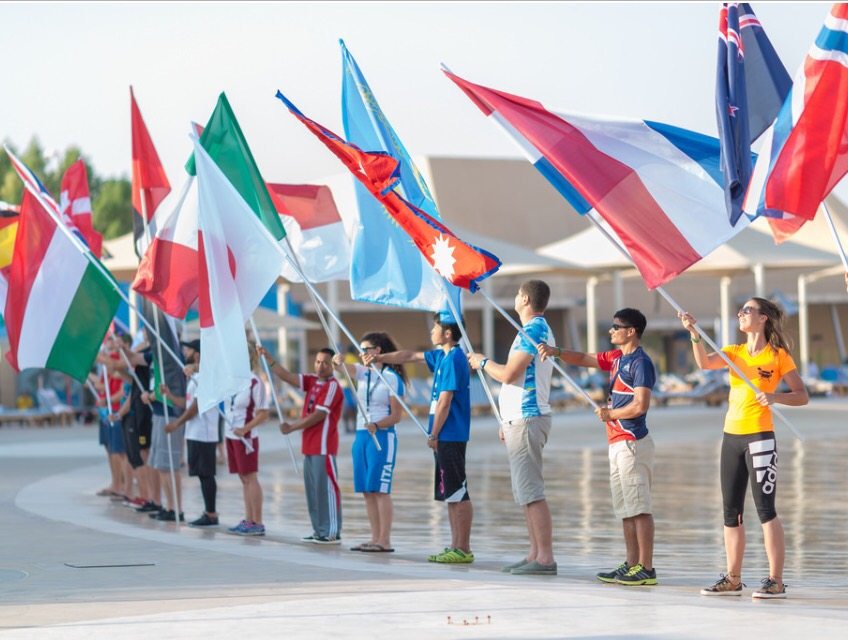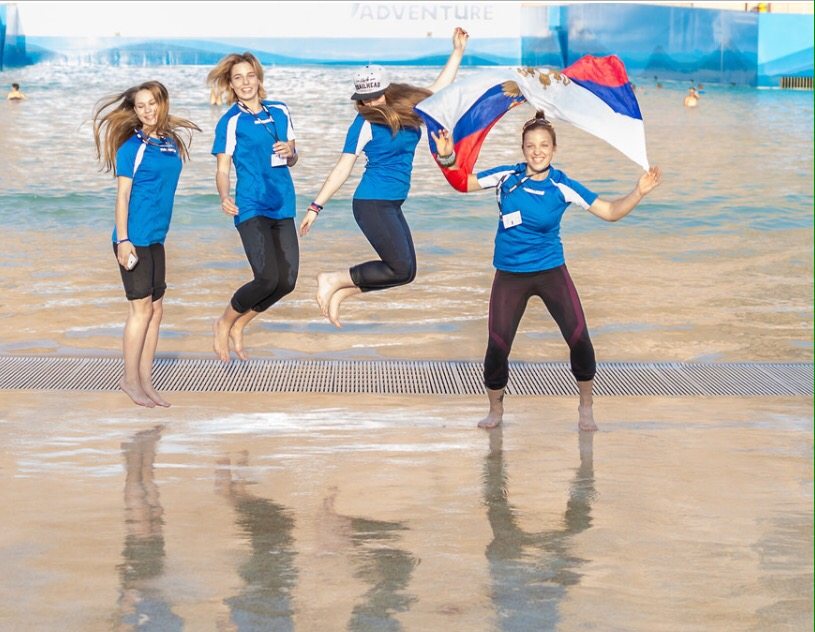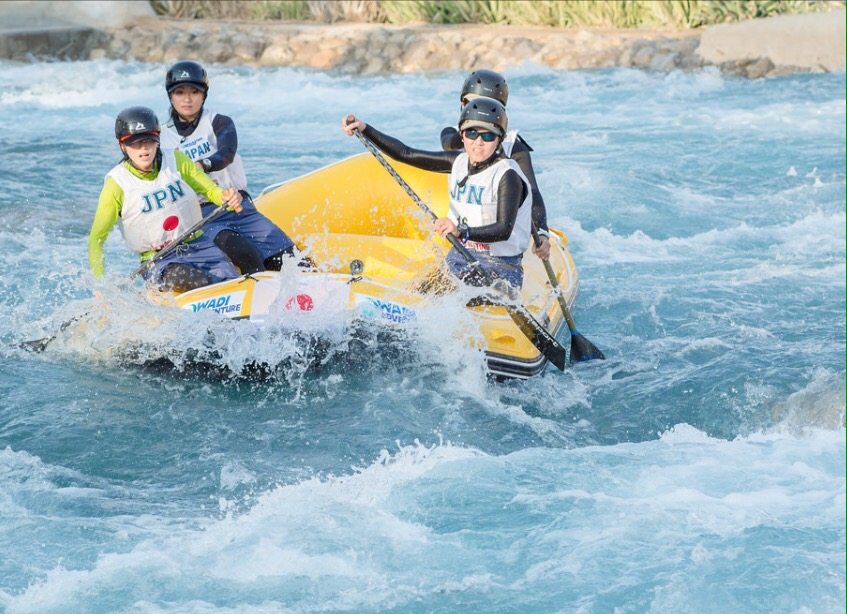EDITOR’S DESK: We continue our international tour de force this month by turning our attention back to the International Rafting Federation. Since in inception of Dirt Bag Paddlers, we have had a warm relationship with the IRF, and also with a few of the teams here in the United States such as the Red Ladies, Ark Sharks, Oregon Raft Team, and Back in Black. The spirit of friendly international competition and community lies at the core of both the IRF and DBP. As our friend Bhupi Singh Rana (an IRF certified safety instructor and founder of Ganga to Kayak Festival in India) told us long ago, “Flow Together, Grow Together!”
I got the opportunity to chat recently with Sue Liell-Cock, Secretary General of the IRF and a legend of raft racing in her own right, on a wide ranging variety of topics concerning the Federation and our global community. Illustrating the interview is the photography of Max Buzin, who captured the action at the 2016 World Championships at Wadi Adventures in Al Ain, Abu Dhabi, United Arab Emirates. The community camaraderie is clear on the faces of all! (For more of Max’s great photography follow him on instagram instagram.com/_maxbuzinphoto )
DBP: The International Rafting Federation has a long history of supporting races around the world and teams in many countries, for both men and women. What common theme brings everyone together?
IRF: The love of rivers and rafting is the initial common denominator, but once they have been to one event there are a whole lot more reasons as to why they want to get together again. There is amazing camaraderie at these events between all the teams and especially amongst each team. I’ve often had people from other sports commenting that they love the IRF events because there is a sense of fun and enjoyment. Although we all take the racing seriously we don’t let it overshadow the reasons why we are doing the sport – the love of rivers and rafting, and making new, like minded friends from all over the world!
DBP: The World Championships are amazing, bringing the best teams from around the world together for friendly competition. Can you tell us about the 2017 venue in the host country of Japan?
IRF: The 2017 event is on the Yoshino River (Koboke section) near Miyoshi City in the Tokushima Prefecture. Everyone has been keen for a number of years to see the WRC back on big white water. It has been on rivers with only Class 3 rapids for too many years in a row now, droughts often being the reason. So we are excited about this river being a big water challenge again. Japan is always so efficient and all the signs are pointing to a very well run and exciting event.
DBP: Rafting competitions help break barriers and encourage a global community outlook. How do you see the sport bring different cultures together?
IRF: The competitive side of the sport was born from Project RAFT (Russians and Americans for Teamwork) and was founded by California river guides Jib Ellison and Mike Grant specifically to break down the barriers between Russian and USA rafters during the cold war. The first event, the Chuya Rally, was a collaborative effort between them and the Siberian river explorer, Misha Kolchevnikov. Having grown out of that we continue to strive to break down any barriers. And it is a great equaliser – when you are on the river you all talk the same language, have the same goals and the same love of what you are doing. So differences tend to fall away in the mutual enjoyment of the sport.
DBP: Many regions get their first taste of whitewater through the IRF. Can you tell us about one of the newer countries to form a team and enter the competition?
IRF: The most interesting has been the United Arab Emirates as it is all desert! But with the excellent and challenging artificial course at Wadi Adventure they do have the possibility to raft now and hence were hosts to last year’s WRC. They put a team together quite late and they did really well for the small amount of time they have spent on white water in their lives! We’re hoping they will expand the number of teams they have and also start running an annual rafting event there so as to grow the sport.
DBP: The Women’s teams are amazingly athletic and the top teams can beat most men’s squads. It is great to see this measure of equality in our sport! What is the IRF’s approach to encouraging more female teams to participate?
IRF: Yes, we can be very proud of our equality. I think it helps having a female in a prime position in the organisation. As I was the first female commercial river guide in South Africa I know how hard it is for females to get recognition in this world, and I believe in them. So they know I’m very approachable and they don’t have to persuade me of their abilities. But a huge amount of credit must go to the female teams themselves – they are generally far more organised than the men’s! They seem to be able to raise the money more easily and tend to get their registration details in first. When the economic crunch hit a number of years back the number of men’s teams dropped significantly and has stayed down, but the women’s dropped less and has crept up to close to the same number as men’s teams.
DBP: The sport of rafting is given a huge boost in developing markets by bringing training and gear into areas where the whitewater rivers are top notch but the commercial outfitters haven’t yet penetrated, such as in South America, Africa, and Asia. What sorts of rescue and guide courses are currently offered, and are there special programs for poorer regions?
IRF: Our aim with our Guide Training & Education sector is to ensure river safety for everyone wherever they are. Our certification scheme is getting greater recognition every year around the world and is the recognised international standard for commercial rafting by many commercial companies, regions, a number of governments as well as the Adventure Travel Trade Association. We do have a certain amount of funding for our GTE Assessors to run workshops in areas which we feel would really benefit. The aim is to train up Instructors in all areas so that they can continue the courses and workshops and so raise the safety standards. We try to keep costs as low as possible so that all can afford it – the aim is safety not making money. We offer guide, trip leader, instructor and assessor certifications on the different classes of whitewater. We also offer safety kayaker certification and are bringing in an event safety certificate. With the right skills rivers can be enjoyed much more.
DBP: The United States lags far behind the European teams in terms of national interest and even participation in raft racing on a dedicated level. The American branch of Dirt Bag Paddlers have tried to heighten interest with coverage of IRF events over the last few years, especially by supporting our women’s teams. Why do you think raft racing hasn’t been more popular here? Is it the lack of a competitive river culture?
IRF: The USA had a huge number of teams attending Project RAFT and were the champions a number of times. But when the WRC started only the USA’s best men’s and best women’s teams could go – and they were REALLY good in those days! Laurence Alvarez-Roos, Todd Brownell and Company and Beth Rypins, Kelly Kalafatich and Company were leagues above the other USA teams. This seemed to drive the incentive away for the other teams. Once these teams retired (but should come back for Masters!!!) it started opening up more opportunities for other teams and slowly the number of teams has grown. The other really big factor is the usual one – money. Without funding it is really hard to attend international and, in the USA, even national events. The USA teams have become quite inventive in raising these funds and by having the selections a year ahead it gives them more time to find that funding. Using the National Selections and other races to raise funds for those teams is essential as well – this is how many federations do it internationally. I do see a steady growth there and your work with DBP is certain to help that growth too!
DBP: The IRF is a non-profit organization. How do you pull off the events around the world on a shoestring budget?
IRF: With great difficulty! We are very reliant on potential hosts wanting the event and them finding the funding for it. This is not ideal as it means we go where the money dictates instead of where the best venues are or where we should go so as to spread the event around the continents. Our ideal is to find a great sponsor who will fund us choosing the right locations each time. We try to keep the membership and other costs affordable because we know rafters tend not to be big earners. We also try focus on growing our media profile as we know that is what sponsors want to see.
DBP: One of the most wildly successful World Championships was the races held on the Zambezi River in Africa almost 20 years ago. What has changed in raft racing since those days?
IRF: Those were the days we had a big sponsor and could choose the best rivers. The Race Rules are now three times the length! The other significant change is how close the teams are in the races. This dictated the compulsory use of electronic timing. When you have teams that race a Downriver over many kilometres, in different groups, and their times are hundreds of a second different – you need good electronic timing not stopwatches! And of course the number of teams and countries participating has grown significantly, often with unusual teams doing well (like Netherlands whose land is flat!). The preparation and training that the teams do these days is huge!
DBP: We at DBP are saddened by the impending loss of the Batoka Gorge of the Zambezi due to a massive dam project. Is there an official stance by the IRF towards these mega projects that rob us of some of our best whitewater?
IRF: Definitely! And that stance is that we are dead against them for so many reasons. Besides it robbing us of awesome whitewater there are so many alternatives to damming. That section of Africa has incredible solar potential at a fraction of the cost. But often these projects are driven by money hungry and unscrupulous organisations and people who have little care for the long term effect they will have on the river or the local communities. It is hard to fight but organisations like International Rivers are awesome and deserve all our support. The really good news is that there is going to be a raft race there this year! 14 – 21 Dec and it will be recognised as one of the IRF World Cup series events. So keep an eye on the IRF’s website for more info on that – and mark your calendars!
DBP: We certainly will! And we will bring home coverage!! Sue, thanks so much for your time, and we look forward to a great season of races this year! One last set of questions. What is the biggest challenge facing the future of international competition? What is the most hopeful attribute?
IRF: Funding the ever growing monster is the greatest challenge. To ensure we have the right people driving the right sectors forward we need to compensate them for their time – only so much can be done as volunteers.
But that is a good sign in itself! The fact that it is growing so rapidly in all its sectors – from raft racing, to guide training and safety to conservation – is excellent news! It is a massive family, spread all around the world, and every little bit of good that is done to grow the sport by every person out there is what makes this sport great. Thanks DBP for your part!
DBP: You bet! Cheers!!
POSTSCRIPT: The following photos are from International Rafting Federation files from various races over the past few years from Brazil, Slovenia, Ecuador, Indonesia, and Austria. They demonstrate the passion of competition, the worldwide scope of the organization, the friendly nature of the teams, and the spectacular natural beauty of the rivers of our world. Also there are some photos from the rescue and raft guide programs offered by the IRF. These images truly highlighting the special community that is the International Rafting Federation!

























